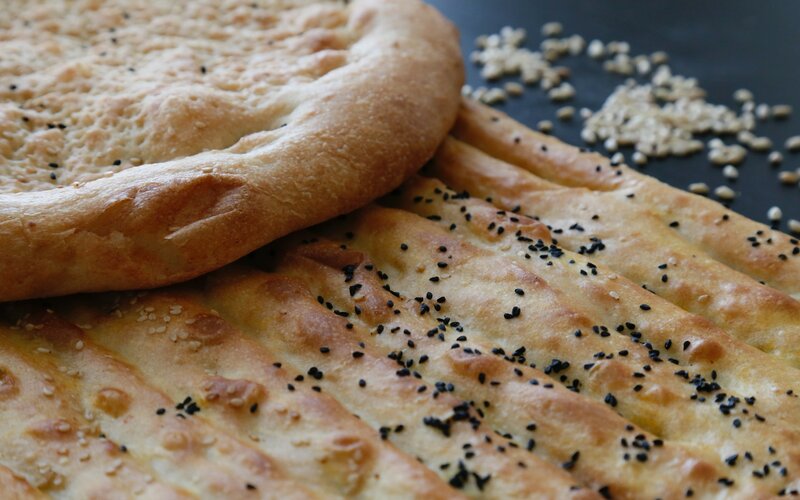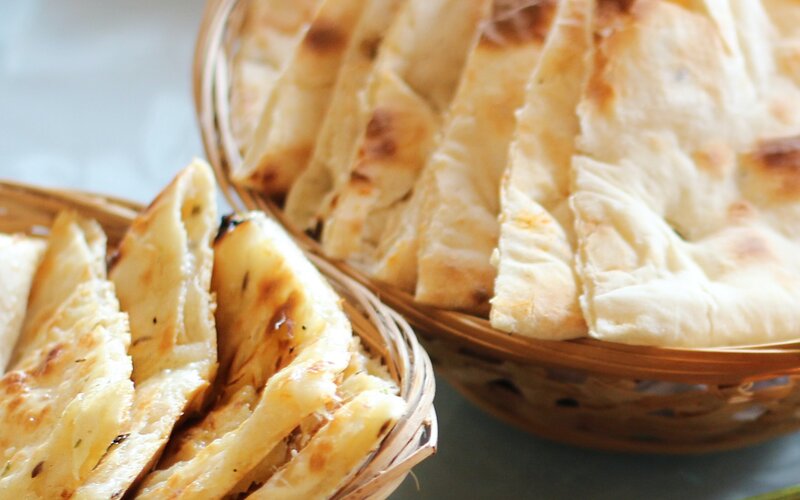
Bread is an important part of Indian cuisine. It’s the perfect accompaniment to many dishes. Commonly used to soak up all the flavours of a Tadka dal or a creamy butter chicken, or utilized to form the perfect case for a chargrilled tikka kebab, bread is also a great neutraliser for those spicier dishes.
There are many types of bread used in Indian cooking, so let’s take a look at some of the most popular.
Types of Indian bread
Whether you’re looking for a dough with that perfect chew or one with a light crunch, there is an Indian bread that fits the bill. Read on to learn more about the different variations of bread in Indian cooking.

Naan Bread
Soft on the inside and lightly crisp on the edges, naan bread is the perfect vehicle for other dishes to rely on. Used to scoop up sauces or ready to be loaded with chutneys, naan is “probably the most popular Indian bread you can ever get”, says Indian Michelin star chef, Vineet Bhatia, in his online Indian cooking course.
A nice tear of the naan, dipped into a little sauce is absolutely fantastic
Vineet Bhatia
Part of a naan’s magic is that it’s made inside a tandoor – a large urn-shaped oven made from clay. Here, intense heat creates air bubbles and even scorches the dough in some places, which lends to that soft but crispy texture many of us love.
There are many variations of naan bread – from flavoured naans to stuffed naans. And they usually come in round circles or are tear-shaped. Some of the most popular flavoured variations are plain naan, Peshwari naan, garlic and coriander naan and cheese naan.
A good plain naan dough needs strong bread flour, yeast, black onion seeds, milk, and yoghurt – to give the naan that tanginess. But for some of those flavoured doughs, you can find some more exciting ingredients that pack a punch.
Peshwari naan uses a combination of desiccated coconut, almond powder, cardamom powder, dried fruits like sultanas or raisins, and a small bit of condensed milk to bring that sweetness together.
Garlic and coriander naan is a common variation found on the menus of Indian restaurants or takeaways. Coriander is embedded into the dough mix and, to give these their unique flavour, the naan is brushed with a garlic butter and sprinkled with more coriander once cooked.
Cheese naan is one of Vineet’s favourite variations. In his BBC Maestro Indian cooking course, he highlights cheddar cheese, mozzarella or soft cheese paired with red onion and chopped coriander as a winning combo.

Chapati
This Indian bread is made from really simple ingredients – wheat flour, salt and water. Many of today’s chapati recipes call for oil too.
Originating from the Indian subcontinent, chapati is a staple in the diets of those in India, Nepal, Bangladesh, Pakistan, Sri Lanka, East Africa, the Arabian Peninsula and even the Caribbean. Its soft, light and fluffy texture is excellent for soaking up sauces or dips. It’s also a little chewier than other Indian flatbreads like roti.
Like many Indian breads, chapatis don’t take long to cook at all. Usually, 30 seconds on both sides of a hot griddle pan is enough. Chapatis are famously known to inflate when cooking but once flipped onto the other side and removed from the heat this subsides, resulting in a flat-bread style bread. You will often find chapatis are brushed down with butter or ghee when served.

Roti
Very similar to chapati is the roti. The main difference separating the two is that roti uses whole-wheat flour rather than wheat flour, and the two can be cooked slightly differently.
Like chapati, roti uses very simple ingredients. To make roti, you only need whole-wheat flour and water. Some recipes call for oil, but it isn’t necessary.
One of the traditional ways roti is cooked is using a Tawa – a special Indian frying pan. It’s a flat wok or griddle pan which is used to make flatbreads and fry thin slices of meat or paneer in Indian cooking. You may also find a tandoori roti on a menu too. This uses a tandoor in its method of cooking. The dough is thrown repetitively against the insides of the tandoor oven to cook them quickly. The roti turn crispy on the bottom and bubbly on the top. Another separating factor between a chapati and a roti, is that chapati’s are only ever cooked in a Tawa and not a tandoor.
Like the other breads in this article, they are often served as a side dish to dahl’s, curries and stews.

Pao rolls
This soft bun is particularly close to Vineet Bhatia’s heart. “These bring back memories of my childhood, especially eating them with kheema in my favourite dish kheema pao,” he says in his BBC Maestro course.
Pao is a bun that originated in Bombay. You can get them in other parts of India, but there is something uniquely special about a pao roll from Bombay, according to Vineet Bhatia.
“The top of the bread is nice and brown. It’s very light, it’s very aerated and it is very fluffy. When you compress it, it bounces back. But the most important thing is, the pao is never sweet,” says Vineet Bhatia. And no other bread roll around the world that he has tried can compare to it.
Flour is the base for a pao. One that has a strong-gluten content. But you also need yeast, salt and warm water too. A good pao has a light brown, soft surface. This is down to milk wash brushed on top before they go into the oven, giving them that perfect glaze. Many people in India use pao rolls for sandwiches or mopping up leftover sauces, but they are delicious enough on their own with a bit of butter or fried in ghee.
Dosa
Unlike the plumpness of a Pao bun, a dosa’s texture is quite the opposite. Made from a thin batter, a dosa is a pancake made from fermented rice and lentils.
Its origins lie in Southern India, but they’re celebrated across the country for their flavours, fragrances and simplicity. Much like the humble western pancake, dosas are eaten at all times of the day – for breakfast, lunch and dinner, or as a snack. They are often eaten plain alongside chutneys, dips and sambar (a lentil-based vegetable stew) but they can also be stuffed with vegetables and sauces for a more fulfilling meal.
There are plenty of dosa variations. From Masala dosa (where spiced potatoes are tucked inside the dosa with red chutney) and paneer dosa (with spiced paneer cheese inside) to Kari Dosa (a Tamil Nadu speciality containing cooked meat – usually chicken or mutton), a dosa is a pretty versatile dish.
So, which one are you ready to try? Has the coconutty-sweetness of a Peshwari naan tickled your fancy? Or perhaps the sponginess of a pao roll has you tempted? Whatever your craving, any one of these breads can elevate your home-cooked Indian dishes.
If you’re ready to give them a try or add a few more Indian recipes to your repertoire, take a deeper look at Vineet Bhatia’s course on Modern Indian cooking.

Give the gift of knowledge
Surprise a special someone with a year's access to BBC Maestro or gift them a single course.





